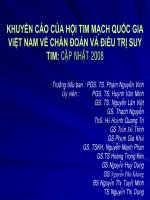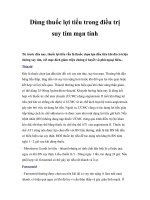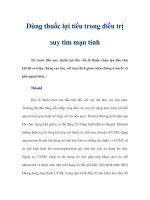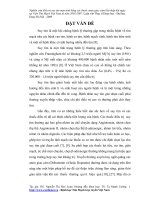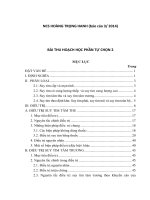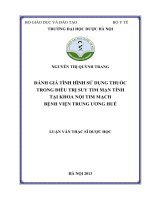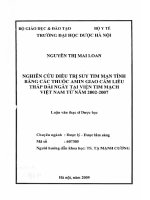Cập nhật điều trị suy tim mạn
Bạn đang xem bản rút gọn của tài liệu. Xem và tải ngay bản đầy đủ của tài liệu tại đây (4.95 MB, 51 trang )
CẬP NHẬT ĐIỀU TRỊ
SUY TIM MẠN TÍNH
Ths.BSNT. Nguyễn Thị Minh L{
Bộ môn Tim mạch ĐHY Hà Nội
Viện Tim mạch Việt Nam
TỪ CÁC YẾU TỐ NGUY CƠ ĐẾN SUY TIM TÂM THU
Rối loạn
chức năng
Tâm thu
Nhồi máu cơ tim
RL nhịp tim
Tái cấu trúc
Huyết khối ĐMV
Thiếu máu cơ tim
Hoạt hóa hệ thần kinh
– thể dịch
RL chức năng thận
Phì đại thất trái
liên quan tới mảng xơ vữa
Gđ A
* Yếu tố nguy cơ
THA
RL Lipid máu
ĐTĐ
Hút thuốc lá
Bệnh thận
Đột tử
Gđ B
Phì đại thất trái
Suy tim
Gđ C & D
Tử vong
CP1154571-127
TÁI CẤU TRÚC CƠ TIM
Chẩn đoán suy tim
Đánh giá mức độ suy tim
Theo NYHA
Phân loại trên lâm sàng
Dựa trên mức độ hoạt động thể lực
hàng ngày và hạn chế về tr/c cơ năng.
Khuyến cáo của Hội Nội khoa Việt
nam.
aa â â aa aa
1. Có bệnh tim, nhưng không có tr/c
cơ năng. Sinh hoạt và hoạt động
thể lực gần như thường.
1. Bệnh nhân có khó thở nhẹ,
nhưng gan chưa sờ thấy.
2. Tr/c cơ năng chỉ xuất hiện khi gắng
sức nhiều. Giảm nhẹ các hoạt
động thể lực.
2. Bệnh nhân khó thở vừa, gan to
dưới bờ sườn vài cm.
3. Bệnh nhân khó thở nhiều, gan
3. Tr/c cơ năng xuất hiện kể cả khi
to gần sát rốn nhưng khi được
gắng sức rất ít. Hạn chế nhiều các
điều trị có thể nhỏ lại.
hoạt động thể lực.
4. Bệnh nhân khó thở thường
4. Tr/c cơ năng tồn tại thường xuyên
xuyên, gan luôn to mặc dù đã
kể cả khi nghỉ ngơi.
được điều trị.
PHÂN LOẠI SUY TIM
Phân độ suy tim theo NYHA
Giai đoạn Suy tim theo ACC/AHA
Có Có
Nguy
Nguy
cơ cơ
caocao
suySTtim
song
song
không
không
A Acó có
bệnh
bệnh
timtim
thực
thực
tổntổn
hoặc
hoặc
không có
biểu
không
hiện có
suybiểu
tim hiện suy tim
Có Có
bệnh
bệnh
timtim
thực
thực
tổntổn
nhưng
nhưng
không
B B
có không
biểu hiện
có biểu
suy tim
hiện suy tim
Bệnh
Bệnh
timtim
thực
thực
tổntổn
đã đã
hoặc
hoặc
đang
đang
có
C C
biểu
cóhiện
biểusuy
hiệntim
suy tim
I
I Không
có triệu
chứngchứng
cơ năng
Không
có triệu
cơ năng
triệu
chứng
khisức
gắng
II II CóCó
triệu
chứng
khi gắng
vừasức vừa
IIIIII CóCó
triệu
chứng
khi gắng
nhẹsức nhẹ
triệu
chứng
khisức
gắng
timtim
kháng
trơ, trị,
đòiđòi
hỏihỏi
phải
phải
cáccó
biện
các IVIV
D DSuySuy
CóCó
triệu
chứng
ngay cả
lúc nghỉ
triệu
chứng
ngay
cả lúc nghỉ
biện
pháp
pháp
điều
điều
trịtrị
đặc
đặc
biệt
biệt
ĐIỀU TRỊ SUY TIM
ACEI & diuretic:
Reduces the number of sacks on the wagon
ß-Blockers
Limit the donkey’s speed, thus saving energy
DIGOXIN
Like the carrot placed in front of the donkey
Bằng chứng điều trị thuốc đối với
suy tim CNTT giảm (HFrEF-C)
Recommendations
COR
LOE
I
C
ACE inhibitors are recommended for all patients with HFrEF
I
A
ARBs
ARBs are recommended in patients with HFrEF who are ACE inhibitor intolerant
I
A
ARBs are reasonable as alternatives to ACE inhibitor as first line therapy in HFrEF
IIa
A
The addition of an ARB may be considered in persistently symptomatic patients with HFrEF on GDMT
IIb
A
III: Harm
C
I
A
I
A
I
B
III: Harm
B
I
A
IIa
B
Diuretics
Diuretics are recommended in patients with HFrEF with fluid retention
ACE Inhibitors
Routine combined use of an ACE inhibitor, ARB, and aldosterone antagonist is potentially harmful
Beta Blockers
Use of 1 of the 3 beta blockers proven to reduce mortality is recommended for all stable patients
Aldosterone Antagonists
Aldosterone receptor antagonists are recommended in patients with NYHA class II-IV HF who have LVEF
≤35%
Aldosterone receptor antagonists are recommended in patients following an acute MI who have LVEF
≤40% with symptoms of HF or DM
Inappropriate use of aldosterone receptor antagonists may be harmful
Hydralazine and Isosorbide Dinitrate
The combination of hydralazine and isosorbide dinitrate is recommended for African-Americans, with
NYHA class III–IV HFrEF on GDMT
A combination of hydralazine and isosorbide dinitrate can be useful in patients with HFrEF who cannot
be given ACE inhibitors or ARBs
J Am Coll Cardiol, 2013: 10.1016/j.jacc.2013.05.020.
Bằng chứng điều trị thuốc đối với
suy tim CNTT giảm (HFrEF-C)
Recommendations
COR
LOE
IIa
B
I
A
I
C
IIa
B
III: No
Benefit
B
III: No
Benefit
A
IIa
B
Nutritional supplements as treatment for HF are not recommended in HFrEF
III: No Benefit
B
Hormonal therapies other than to replete deficiencies are not recommended in HFrEF
III: No Benefit
C
III: Harm
B
III: Harm
C
III: No Benefit
A
Digoxin
Digoxin can be beneficial in patients with HFrEF
Anticoagulation
Patients with chronic HF with permanent/persistent/paroxysmal AF and an additional risk factor for
cardioembolic stroke should receive chronic anticoagulant therapy*
The selection of an anticoagulant agent should be individualized
Chronic anticoagulation is reasonable for patients with chronic HF who have
permanent/persistent/paroxysmal AF but without an additional risk factor for cardioembolic stroke*
Anticoagulation is not recommended in patients with chronic HFrEF without AF, prior thromboembolic
event, or a cardioembolic source
Statins
Statins are not beneficial as adjunctive therapy when prescribed solely for HF
Omega-3 Fatty Acids
Omega-3 PUFA supplementation is reasonable to use as adjunctive therapy in HFrEF or HFpEF patients
Other Drugs
Drugs known to adversely affect the clinical status of patients with HFrEF are potentially harmful and
should be avoided or withdrawn
Long-term use of an infusion of a positive inotropic drug is not recommended and may be harmful
except as palliation
Calcium Channel Blockers
Calcium channel blocking drugs are not recommended as routine in HFrEF
J Am Coll Cardiol, 2013: 10.1016/j.jacc.2013.05.020.
Bằng chứng điều trị bằng các thiết bị đối với
suy tim CNTT giảm (HFrEF-C)
Recommendations
COR
LOE
ICD therapy is recommended for primary prevention of SCD in selected patients with HFrEF at least 40 days postMI with LVEF ≤35%, and NYHA class II or III symptoms on chronic GDMT, who are expected to live ≥1 year*
I
A
CRT is indicated for patients who have LVEF ≤35%, sinus rhythm, LBBB with a QRS ≥150 ms
I
ICD therapy is recommended for primary prevention of SCD in selected patients with HFrEF at least 40 days postMI with LVEF ≤30%, and NYHA class I symptoms while receiving GDMT, who are expected to live ≥1 year*
I
B
IIa
A
CRT can be useful for patients who have LVEF ≤35%, sinus rhythm, a non-LBBB pattern with a QRS ≥150 ms, and
NYHA class III/ambulatory class IV symptoms on GDMT.
CRT can be useful for patients who have LVEF ≤35%, sinus rhythm, LBBB with a QRS 120 to 149 ms, and NYHA class
II, III or ambulatory IV symptoms on GDMT
CRT can be useful in patients with AF and LVEF ≤35% on GDMT if a) the patient requires ventricular pacing or
meets CRT criteria and b) AV nodal ablation or rate control allows near 100% ventricular pacing with CRT
CRT can be useful for patients on GDMT who have LVEF ≤35%, and are undergoing new or replacement device
with anticipated (>40%) ventricular pacing
An ICD is of uncertain benefit to prolong meaningful survival in patients with high risk of nonsudden death such as
frequent hospitalizations, frailty, or severe comorbidities*
CRT may be considered for patients who have LVEF ≤35%, sinus rhythm, a non-LBBB pattern with QRS 120 to 149
ms, and NYHA class III/ambulatory class IV on GDMT
CRT may be considered for patients who have LVEF ≤35%, sinus rhythm, a non-LBBB pattern with a QRS ≥150 ms,
and NYHA class II symptoms on GDMT
CRT may be considered for patients who have LVEF ≤30%, ischemic etiology of HF, sinus rhythm, LBBB with a QRS
≥150 ms, and NYHA class I symptoms on GDMT
IIa
B
A
B
IIa
B
IIa
C
IIb
B
IIb
B
IIb
B
IIb
C
CRT is not recommended for patients with NYHA class I or II symptoms and non-LBBB pattern with QRS <150 ms
III: No Benefit
B
CRT is not indicated for patients whose comorbidities and/or frailty limit survival to <1 year
III: No Benefit
C
J Am Coll Cardiol, 2013: 10.1016/j.jacc.2013.05.020.
Thuốc dùng cho suy tim CNTT giảm (HFrEF-C)
Liều khởi đầu hàng ngày
Liều tối đa
Liều trung bình qua các
TNLS
Captopril
6.25mg X 3 lần/ngày
50mg X 3 lần/ngày
122.7mg/ngày
Enalapril
2.5mg X 2 lần/ngày
10-20mg X 2 lần/ngày
16.6mg/ngày
Fosinopril
5-10 mg X 1 lần/ngày
40mg X 1 lần/ngày
---------
Lisinopril
2.5-5 mg X 1 lần/ngày
20-40mg X 1 lần/ngày
32.5-35.0mg/ngày
Perindopril
2mg X 1 lần/ngày
8-16 mg X 1 lần/ngày
---------
Quinapril
5mg X 2 lần/ngày
20mg X 2 lần/ngày
---------
Ramipril
1.25-2.5mg X 1 lần/ngày
10mg X 1 lần/ngày
---------
1mg X 1 lần/ngày
4mg X 1 lần/ngày
---------
4-8mg X 1 lần/ngày
32mg X 1 lần/ngày
24mg/ngày
25-50mg X 1 lần/ngày
50-150 mg X13 lần/ngày
129mgngày
160mg X 2 lần/ngày
254mg/ngày
25mg X 1-2 lần/ngày
26mg/ngày
25mg X 1 lần/ngày
50mg X 1 lần/ngày
42.6mg/ngày
Bisoprolol
1.25mg X 1 lần/ngày
10mg X 1 lần/ngày
8.6mg/ngày
Carvedilol
3.125mg X 2 lần/ngày
50mg X 2 lần/ngày
37mg/ngày
10mg X 1 lần/ngày
80mg X 1 lần/ngày
---------
12.5-25mg X 1 lần/ngày
200mg X 1 lần/ngày
159mg/ngày
HDR 75mg/ISDN 40mg X 3lần/ng
HDR 300mg/ng và ISDN 120mg/ng
chia nhỏ liều
~175mg HDR+90mg ISDN/ng
Thuốc
Ức chế men chuyển (ACE Inhibitors)
Trandolapril
Chẹn thụ thể angiotensin (ARBs)
Candesartan
Losartan
Valsartan
20-40mg X 2 lần/ngày
Kháng aldosterine (Aldosterone Antagonists)
Spironolactone
12.5-25 mg X 1 lần/ngày
Eplerenone
Chẹn beta giao cảm (Beta Blockers)
Carvedilol CR
Metoprolol succinate (CR/XL)
Phối hợp Hydralazine (HDR) & Isosorbide Dinitrate (ISDN)
Phối hợp liều cố định
Hydralazine và ISDN
HDR 37.5mg+ISDN 20mg X 3l/ng
HDR 25-50mg X 3- 4l/ngày và ISDN
20-30 mg X 3-4 lần/ngày
---------
J Am Coll Cardiol, 2013: 10.1016/j.jacc.2013.05.020.
Thử nghiệm lâm
sàng (năm công
bố kết quả n/cứu)
N=
Mức độ
suy tim
Điều trị
nền tảng
Điều trị mới
Thời
gian
năm
Tiêu chí
nghiên
cứu
Giảm
RR (%)
Số biến cố dự phòng
được/1000 bệnh nhân điều
trị
tử
vong
vviện
STim
tử vong/
vviện ST
Ức chế men chuyển dạng (ACEI)
CONSENSUS,1987
253
gđoạn cuối
spiro
enalapril 20mg bid
0,54
tử vong
40
146
-
-
SOLVD-T, 1991
2569
nhẹ-nặng
-
enalapril 20mg bid
3,5
tử vong
16
45
96
108
Chẹn beta giao cảm (BB)
CIBIS-2, 1999
2647
tbình-nặng
ACEI
bisoprolol 10mg qd
1,3
tử vong
34
55
56
-
MERIT-HF, 1999
3991
nhẹ-nặng
ACEI
metoprolol CR/XL
200mg qd
1,0
tử vong
34
36
46
63
COPERNICUS,2001
2289
nặng
ACEI
carvedilol 25mgbid
0,87
tử vong
35
55
65
81
SENIORS, 2005
2128
nhẹ-nặng
ACEI+spir
o
nebivolol 10mg qd
1,75
tử vong/
vviện BTM
14
23
0
-
Ức chế thụ thể angiotensin (ARB)
Val-HeFT, 2001
5010
nhẹ-nặng
ACEI
valsartan 160mg
bid
1,9
chết/biến
chứngBTM
13
0
35
33
CHARMAlternative, 2003
2028
nhẹ-nặng
BB
candesartan 32mg
qd
2,8
chết BTM/
vviện STim
23
30
31
60
CHARM-Added,
2003
2548
tbình-nặng
ACEI+BB
candesartan 32mg
qd
3,4
chết BTM/
vviện STim
15
28
47
39
V-HeFT-1, 1986
459
nhẹ-nặng
-
hydralazine 75mg
tid &ISDN 40mgqid
2,3
tử vong
34
52
0
-
A-HeFT, 2004
1050
tbình-nặng
ACEI+BB
+ spiro
hydralazine 75mg
tid & ISDN 40mgtid
0,83
biến cố
gộp
-
40
80
-
Hydralazine-ISDN
Thử nghiệm lâm
sàng (năm công
bố kết quả n/cứu)
Thời
gian
năm
Tiêu chí
nghiên
cứu
Giảm
RR (%)
digoxin
3,1
tử vong
n-3 PUFA 1g qd
3,9
Mức độ
suy tim
Điều trị
nền tảng
Điều trị mới
6800
nhẹ-nặng
ACEI
6975
nhẹ-nặng
ACEI+BB
+spiro
N=
Số biến cố dự phòng
được/1000 bệnh nhân điều
trị
tử
vong
vviện
STim
tử vong/
vviện ST
0
0
79
73
tử vong
chết/vvTM
9
8
18
0
0
-
-
19
38
-
87
Digitalis trợ tim
DIG, 1997
n-3 PUFA
GISSI-HF, 2008
Điều trị tái đồng bộ thất (CRT và CRT-ICD)
COMPANION,
2004
925
CARE-HF, 2005
813
tbình-nặng
ACEI+BB
+spiro
CRT
1,35
tử
vong/vviệ
nbấtkz
tbình-nặng
ACEI+BB
+spiro
CRT
2,45
tử vong/
vviện TM
37
97
151
184
CRT-ICD
1,35
tử
vong/vviệ
nbấtkz
20
74
-
114
COMPANION,
2004
903
tbình-nặng
ACEI+BB+
spiro
MADIT-CRT, 2009
1820
nhẹ
ACEI+BB+
spiro+ICD
CRT-ICD
2,4
tử
vong/biến
cố ST
34
5
-
-
nhẹ-nặng
ACEI+BB
ICD
3,8
tử vong
23
-
-
-
ACEI +
spiro
LAVD
1,8
tử vong
48
282
-
-
Cấy máy phá rung (ICD)
SCD-HeFT, 2005
1676
Thiết bị hỗ trợ thất trái (LAVD)
REMATCH, 2001
129
gđoạn cuối
Xử trí theo từng giai đoạn suy tim
Jessup M et al. N Engl J Med 2003;348:2007-18.
J Am Coll Cardiol. 2013;62(16):e147-e239.
Điều trị suy tim 2012
Lợi tiểu
Ức chế men chuyển (hoặc
ức chế thụ thể AT1)
Chẹn beta giao cảm
Kháng aldosterone
Ivabradine
Tái đồng bộ thất, máy phá
rung tự động
Digoxine
Hydralazine-ISDN
…
Eur Heart J 2012;33:1787–1847.


